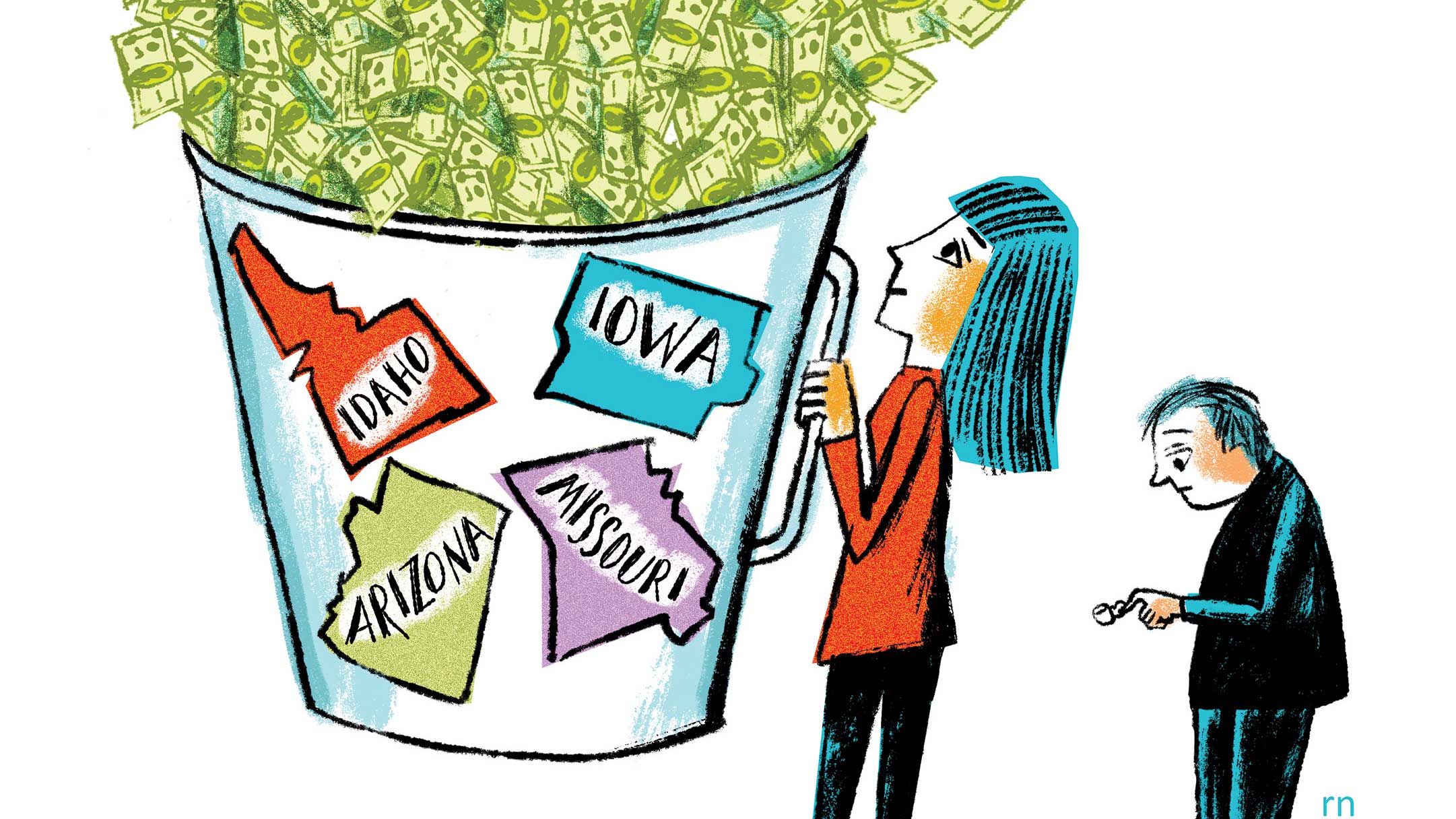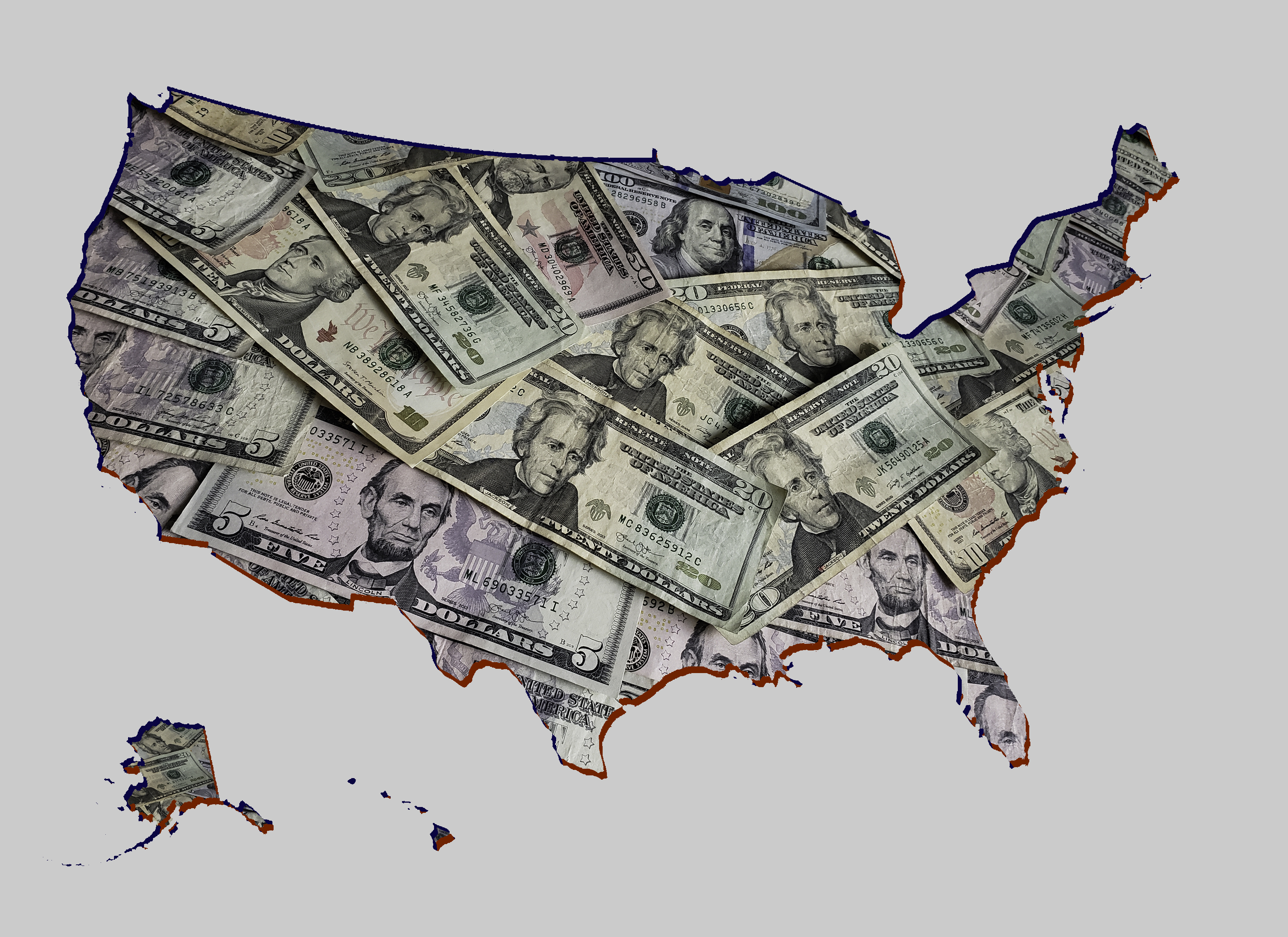Cash-Rich States Lower Taxes
The economic turnaround sparked a wave of cuts in state tax rates. But some say the efforts could backfire.


During the height of the pandemic in early 2020, the economic downturn forced states to furlough employees and cut services. Faced with the prospect of a prolonged recession, state officials braced for steep declines in revenue from sales and income taxes.
But the past year and a half now looks like a horror movie that abruptly turned into a musical. Ten states are so awash in cash that they’ve cut individual income taxes, with some of the tax cuts taking effect in 2021 and others scheduled to phase in over the next few years, according to the Tax Foundation, a tax policy research organization. Some people won’t have to wait for tax relief: Idaho is sending every resident a tax rebate check for $50 or 9% of their 2019 tax bill, whichever is greater.
The dramatic turnaround in state finances was propelled by the economic rebound and revenue from federal stimulus packages. The stimulus legislation also delivered billions of dollars in stimulus checks to individuals, which enabled them to continue to spend money during the pandemic. That bolstered state sales tax revenues, says Katherine Loughead, senior policy analyst for the Tax Foundation’s Center for State Tax Policy. Likewise, enhanced unemployment benefits lessened the economic impact of furloughs and layoffs.
From just $107.88 $24.99 for Kiplinger Personal Finance
Become a smarter, better informed investor. Subscribe from just $107.88 $24.99, plus get up to 4 Special Issues

Sign up for Kiplinger’s Free Newsletters
Profit and prosper with the best of expert advice on investing, taxes, retirement, personal finance and more - straight to your e-mail.
Profit and prosper with the best of expert advice - straight to your e-mail.
The most common form of state tax relief is a reduction in top tax rates, along with a consolidation of tax brackets. For example, Arizona’s state legislature lowered taxes for residents with income of more than $250,000 ($500,000 for married couples filing jointly) starting this year; they will see their top marginal rate drop from 8% to 4.5%. Beginning in 2022, Arizona will also consolidate its four-bracket structure into two brackets, with a 2.55% rate for income up to $27,272 for single filers ($54,544 for married filers) and a 2.98% rate for income over that amount, down from the current marginal rate of 4.17% on income over $54,444 ($109,088 for married couples). Iowa consolidated its nine tax brackets into four and reduced its top tax rate from 8.5% to 6.5%, effective in 2023. The state had earlier approved tax cuts that depended on meeting certain revenue triggers; the legislation accelerated the reductions by eliminating those triggers.
Although a reduction in top tax rates primarily benefits high earners, other states enacted legislation that will lower taxes for middle- and lower-income taxpayers as well. For example, Montana increased its standard deduction to conform with the federal threshold, which will reduce taxes for taxpayers at the lower end of the income spectrum.
Too soon? Not all states are celebrating an increase in revenue. States that rely heavily on the hard-hit hospitality industry are still struggling to recover from the pandemic. “In Hawaii and Nevada, no one is talking about big income tax cuts,” says Richard Auxier, senior policy associate at the Urban-Brookings Tax Policy Center, a tax research nonprofit. “They’re talking about using funds to plug budget holes and prevent tax increases.”
And even fiscally healthy states could see their tax revenues decline if the highly contagious delta variant of COVID-19 contributes to another hit on the economy. State finances have been volatile during the past two years, Auxier says, and states can no longer rely on federal assistance to get them through downturns. States that cut tax rates will need sustained economic growth to provide enough revenue to fund programs and services, he adds.
Perhaps with that in mind, several states have phased in their tax cuts over several years and/or tied them to revenue targets. Theoretically, that gives them the flexibility to postpone the reductions if they find themselves in fiscal difficulties.
Loughead contends that such a scenario is unlikely because she believes the tax relief will encourage economic growth. “These are reforms that will attract more people to these states, especially when there’s a huge rise in remote work,” she says.
Still, reducing taxes is much more politically palatable than raising them, and if states miss their targets, or find themselves in fiscal distress, Auxier doubts that lawmakers will roll back the scheduled tax cuts. “Anytime a policymaker says, ‘We’ll raise taxes later,’ I raise an eyebrow,” he says.
Profit and prosper with the best of Kiplinger's advice on investing, taxes, retirement, personal finance and much more. Delivered daily. Enter your email in the box and click Sign Me Up.

Block joined Kiplinger in June 2012 from USA Today, where she was a reporter and personal finance columnist for more than 15 years. Prior to that, she worked for the Akron Beacon-Journal and Dow Jones Newswires. In 1993, she was a Knight-Bagehot fellow in economics and business journalism at the Columbia University Graduate School of Journalism. She has a BA in communications from Bethany College in Bethany, W.Va.
-
 Countries That Will Pay You to Move: Cash Grants, Incentives and What to Know
Countries That Will Pay You to Move: Cash Grants, Incentives and What to KnowExplore real relocation incentives — from cash grants and tax breaks to startup funding — that make moving abroad or to smaller towns more affordable and rewarding.
-
 Mortgage Protection Insurance: What It Covers and When It Makes Sense
Mortgage Protection Insurance: What It Covers and When It Makes SenseHow mortgage protection insurance works, what it costs, and when it’s actually useful in a financial plan.
-
 How to Use Your Health Savings Account in Retirement
How to Use Your Health Savings Account in RetirementStrategic saving and investing of HSA funds during your working years can unlock the full potential of these accounts to cover healthcare costs and more in retirement.
-
 State Tax Changes 2026: Is Your State Cutting Taxes This Year?
State Tax Changes 2026: Is Your State Cutting Taxes This Year?Tax Changes As a new year begins, taxpayers across the country are navigating a new round of state tax changes.
-
 3 Major Changes to the Charitable Deduction for 2026
3 Major Changes to the Charitable Deduction for 2026Tax Breaks About 144 million Americans might qualify for the 2026 universal charity deduction, while high earners face new IRS limits. Here's what to know.
-
 Retirees in These 7 States Could Pay Less Property Taxes Next Year
Retirees in These 7 States Could Pay Less Property Taxes Next YearState Taxes Retirement property tax bills could be up to 65% cheaper for some older adults in 2026. Do you qualify?
-
 Estate Tax Quiz: Can You Pass the Test on the 40% Federal Rate?
Estate Tax Quiz: Can You Pass the Test on the 40% Federal Rate?Quiz How well do you know the new 2026 IRS rules for wealth transfer and the specific tax brackets that affect your heirs? Let's find out!
-
 5 Types of Gifts the IRS Won’t Tax: Even If They’re Big
5 Types of Gifts the IRS Won’t Tax: Even If They’re BigGift Tax Several categories of gifts don’t count toward annual gift tax limits. Here's what you need to know.
-
 The 'Scrooge' Strategy: How to Turn Your Old Junk Into a Tax Deduction
The 'Scrooge' Strategy: How to Turn Your Old Junk Into a Tax DeductionTax Deductions We break down the IRS rules for non-cash charitable contributions. Plus, here's a handy checklist before you donate to charity this year.
-
 Tax Refund Alert: House GOP Predicts 'Average' $1,000 Payouts in 2026
Tax Refund Alert: House GOP Predicts 'Average' $1,000 Payouts in 2026Tax Refunds Here's how the IRS tax refund outlook for 2026 is changing and what steps you can take now to prepare.
-
 New IRS Changes to FSA Contribution Limits for 2026: What to Know
New IRS Changes to FSA Contribution Limits for 2026: What to KnowHealth Care Flexible Spending Accounts have tax advantages worth looking into, especially in light of new IRS changes.